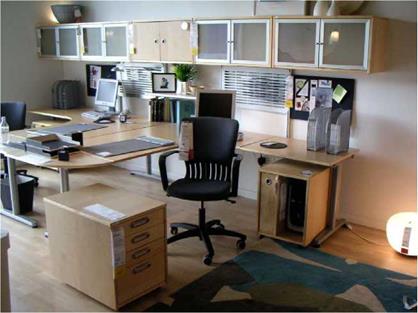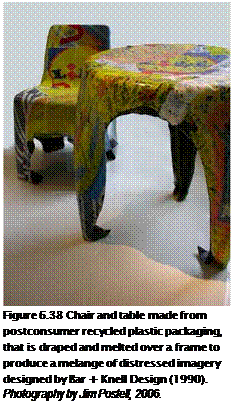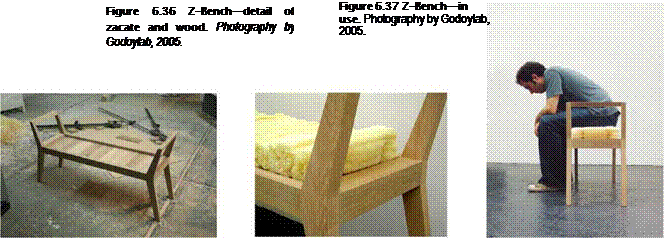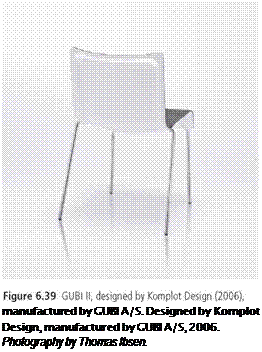Concern for sustainability is more than a matter of compliance with industrial regulation or environmental impact analysis. It embraces a commitment to conceive of the work of design as a part of a wider context in time and place.
The Hannover Principles, William McDonough Architects, 1992
For years, the mantra for sustainable design was "renew, reuse, and recycle." Today, furniture designers invoke green design in more complex and subtle ways. Green design considers distribution and packaging, biodegradability, the life cycle of materials and products, off-gassing, toxicity in fabrication or use, and a number of other important factors including human rights and labor standards.
Sustainable design solutions minimize negative and maximize positive impacts, including social, economic, ethical, and environmental considerations. Leading-edge environmental thinkers and policy makers believe that sustainable development will require a "factor 4" improvement in the environmental performance of goods and services. This means reducing by at least 300 percent over the next 20 to 30 years the amount of resources needed and the pollution generated to deliver goods and services to consumers.5


Flat-pack furniture can reduce the cost of distribution. IKEA has marketed and sold furniture to the public using this method and is recognized as the industry leader for producing inexpensive, practical, and well-designed products (Figure 6.34). The conservation of
endangered materials such as Brazilian rosewood is sustained because many companies no longer offer the material for public consumption. Herman Miller stopped manufacturing the Eames lounge and ottoman in Brazilian rosewood.
Today, many major lumber retail chains buy wood from sustainable forests and offer certified harvested wood to their customers. There are two international forest certification programs, both of which monitor and certify the harvesting and transportation of lumber. The Forest Stewardship Council (FSC) offers a control certification that monitors the transportation and purchase of lumber, giving consumers assurance that the wood was harvested in sustainable forests and certified from stump to retail.6 The Sustainable Forestry Initiative (SFI) is another international program, which monitors the harvesting and transportation of sustainable lumber. Retailers pay a fee to receive certified woods and advertise to consumers that they have done so.7
Since 2003, Brazil no longer exports mahogany wood species, as mandated by its government. Up to that time, Brazil exported 30 percent of the world’s supply of South American mahogany woods, which, along with Cuban mahogany, is considered to be the highest-quality mahogany in the world. In response, many retailers and production factories have secured woods with grain and color characteristics similar to those of Brazilian mahogany, such as sapele.
Many ready-made cabinets are fabricated with a thin wood veneer, covering a substrate of wood shavings pressed together with glue, which can emit formaldehyde gases for years. Consider cabinets made from solid wood, such as a hard pine cut from sustainable forests, or materials that are not endangered or in limited supply. Regenerative bamboo grows quickly, yet is comparable in strength to red oak wood. Choose stains and finishes that contain no volatile organic compounds.
Furniture designer Emiliano Godoy has been researching biodegradable materials for use in design for several years and came upon zacate, a rush used in Mexico and other Latin American countries to scrub dishes or as a bathing sponge. Inspired by the rush, he designed the Z-Bench to highlight the contrast between zacate and wood, treating the materials in completely different ways. Conventional cabinetmaking techniques were used for the wooden structure, while the uncovered and basically raw zacate generates visual tension and comfort when seated (Figures 6.35, 6.36, and 6.37).
The Z-Bench was designed for the show "Diseno Muerto" in Mexico City, organized by Edgar Orlaineta in 2005 for the Galena de Arte Mexicano (GAM).
According to Godoy:
Biological materials are renewable, carbon neutral, and they can share disposal mechanisms. However, we have yet not enough options to substitute technological materials with biological ones. It is clear to me that we need more materials to work with, which participate as active components in Nature’s biomes, and which can be designed to have no environmental impact, or even contribute to the regeneration of what industrial activity has destroyed.8
A series of chair and table designs were conceived and fabricated by Bar + Knell Design between 1993 and 1997. The furniture was produced by heat-forming 100 percent recycled plastic waste. Their furniture designs achieve aesthetic and ecological targets, raise the ethical bar of green design, and increase environmental awareness. The chair and table shown in Figure 6.38 are two of the many furniture pieces (chairs, tables, and screens) designed by Bar + Knell Design.
A study of the material life cycle of furniture has determined that most products are made of nonrenewable materials and, at the end of their useful life, will be discarded and

 |
 |
become landfill. The dilemma today is that the sum of the undesired by-products from furniture and other commercial products exceeds the capacity of the environment to absorb them. Traditional cradle-to-grave concepts are beginning to be reconsidered out of concern for the planet’s environment and ecosystem. William McDonough and Michael Braungart, from McDonough Braungart Design Chemistry, in conjunction with many other individuals and firms, have reconceived the paradigm of green design to embrace the concept of cradle – to-cradle thinking and have developed a collective body of knowledge in biological and technical areas of design. Green design reflects a new way of thinking about design. It is an important frame of reference and is in the foreground of many creative designers.
GUBIII is stackable, lightweight, comfortable, durable, and green. Boris Berlin and Poul Christiansen of Komplot Design designed the chair for the furniture company GUBI. The chair is available in a plain color or two – colored (front different than back) felt made from polyester fibers, a major part of which has been extracted from used plastic water bottles and transformed into a felt material (Figure 6.39). In one single process, two mats made from this felt are molded around a steel tube frame. In this way the industrial process is minimized considerably, since no subsequent upholstery or mounting process is required. There is no inner wooden or plastic shell to support the construction. The supporting qualities are incorporated in the felt. The combination of a straightforward look, great strength, light weight, and easy maintenance makes GUBI II ideal for cafeterias, meeting areas, restaurants, and auditoriums.
Rohner Textile AG is a textile company based in Switzerland that produces textiles for Design Tex and Herman Miller, among other companies. This relatively small company produces Climatex Lifecycle™, which is made of 65 percent wool and 35 percent ramie. It is considered a Jacquard textile, and is biodegradable and environmentally sound, with climate control aspects (making it a good choice for a variety of climate-sensitive situations). It took 18 months to research and manufacture Climatex. When the finished product was introduced to the market at the Solomon Guggenheim Museum in New York City, William McDonough commented in his speech
 to the attending designers and architects, "This is the first product of the Next Industrial Revolution. What we are now saying is that environmental quality can be an integral part of the design of every product. It is no longer a wishful option."9
to the attending designers and architects, "This is the first product of the Next Industrial Revolution. What we are now saying is that environmental quality can be an integral part of the design of every product. It is no longer a wishful option."9
Many furniture designers, including Kaare Klint and Hans J. Wegner, incorporated twisted paper and woven cane in the seat pans of their chair designs during the 1950s and 1960s because alternative means of upholstery were too costly (Figure 6.40). Twisted paper is biodegradable, readily available, local, inexpensive, and comfortable. As one considers green solutions, it becomes easier to recognize environmentally friendly materials, many of which were used before the terms green and sustainable design became part of today’s design lexicon.



